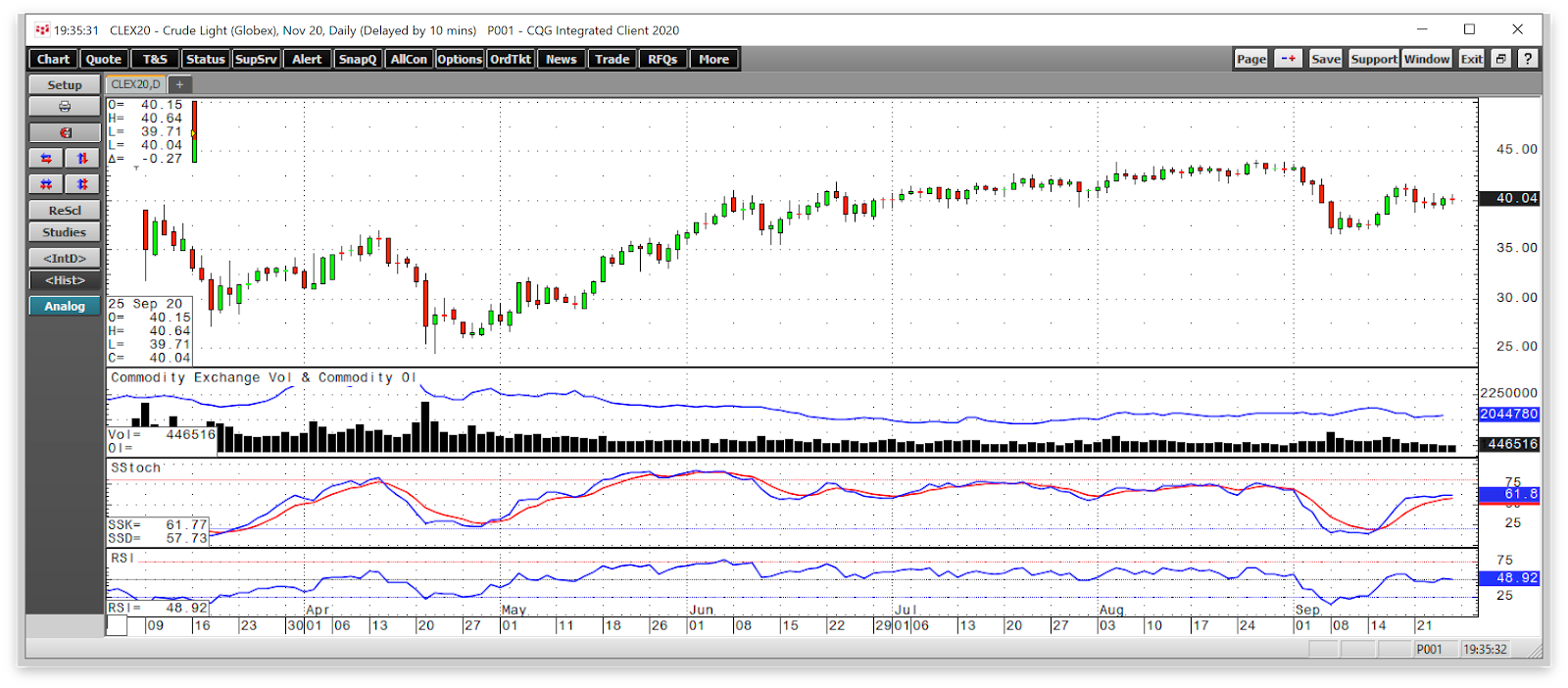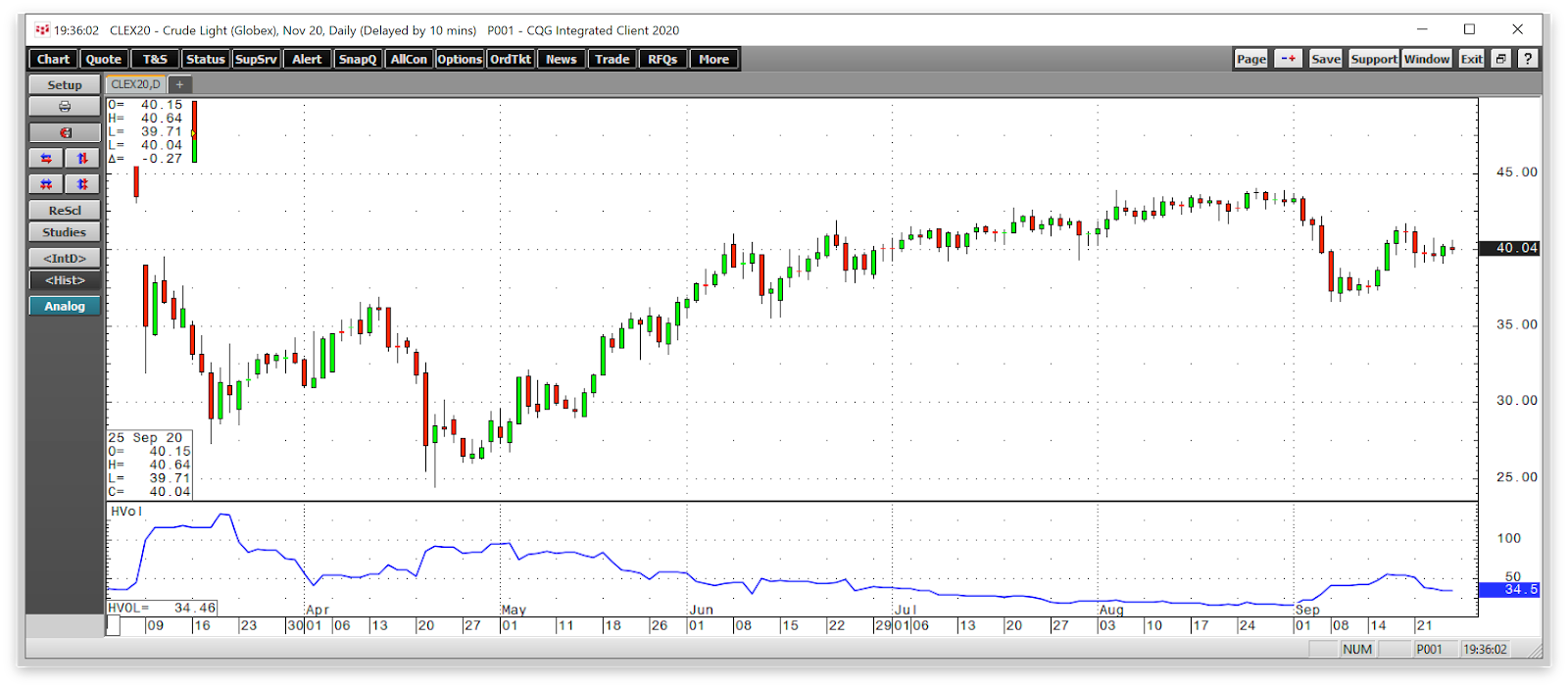Bullish and bearish factors continue to pull the price of crude oil in opposite directions. On the bullish side, central bank liquidity, government stimulus, a weak U.S. dollar, and the Fed’s willingness to tolerate inflationary pressures support all commodity prices.
Moreover, OPEC, Russia and other world producers are sticking with a 7.7-million-barrel-per-day production cut. U.S. production is falling. According to Baker Hughes, 183 oil rigs were operating in the U.S. as of the week ending on Sept. 25, up four from the previous weeks and 530 lower than at the end of September in 2019.
U.S. inventories have been moving lower over the past weeks. Production cuts have gone a long way to balancing the fundamental equation for crude oil.
Meanwhile, the threat of weak demand remains on the horizon as the global pandemic continues to claim victims without a vaccine.
Europe appears to be suffering a second wave of the coronavirus. On Sept. 8, the price of nearby crude oil futures fell to its lowest level since mid-June at $36.13 per barrel. Since then, it returned to the $40 level and was just above there at the end of last week but has dropped nearly $1.50 this week.
Aside from the virus and its impact on demand, the Nov. 3 U.S. election will determine the nation’s policy path for energy production. We should expect continued price variance in the oil futures market over the coming weeks. United States Oil Fund (NYSE:USO) is the ETF product that moves higher and lower with the price of NYMEX crude oil futures.
NYMEX Crude Oil Trades Around $40 Per Barrel Pivot Point
In August, active month November crude oil futures rose to a new high of $44.05 per barrel. On Sept. 8, the energy commodity corrected to a low of $36.58, a decline of 17%.

Source: CQG
As the daily chart highlights, the price returned to the $40 level at the end of last week but has dropped $1.50 in the first two days of trading this week. Nearby NYMEX futures have been trading on either side of $40 since early June.
The risk-off action in the stock market and markets across all asset classes caused the total number of open long and short positions to decline from just below 2.109 million contracts on Sept. 15 to 2.045 contracts at the end of last week.
The move higher in the metric came as the price of oil fell. Speculative shorts with memories of the price carnage earlier this year likely sold the energy commodity as the price declined. When it recovered to $40, they likely covered those risk positions.
Meanwhile, after dropping into oversold territory earlier this month, price momentum and relative strength indicators returned to either side of neutral readings at the end of last week.
$40 on nearby NYMEX crude oil futures has been a pivot point over the past four months.
Historical Volatility Rises In Oil Market
Like many other markets, crude oil tends to take the stairs higher, and an elevator shaft lower when the price declines.

Source: CQG
The November futures contract plunged from a high of $54.14 on Feb. 20 to a low of $24.43 on April 22 or 55%. Over the same period, the continuous contract fell from $54.50 to negative $40.32 per barrel. The elevator shaft ride was hair raising.
During the decline, daily historical volatility on the November contract rose to a high of over 130%, and the weekly metric reached over 170%. The chart shows that the price variance measure steadily declined, reaching a low below 16% in late August.
The recent correction lifted daily historical volatility to a high of over 54% in mid-September. The move back to the $40 level pushed it to the 34.5% level at the end of last week. The metric remains at an elevated level as the crude oil market searches for direction.
The fall and winter seasons tend to be a weak time of the year for energy prices. However, the oil market is likely in wait and see mode when it comes to the Nov. 3 election in the U.S.
Election Should Keep Price Variance High Over Rest Of 2020
Republicans and Democrats in Washington do not agree on much these days. The recent passing of Supreme Court Justice Ruth Bader Ginsburg and President Donald Trump’s nomination of a replacement has only inflamed passions on both sides of the political aisle.
Sadly, the spirit of the Justice, who established a friendship with her political nemesis on the bench, Justice Scalia, is lost on the leaders who prepare to face-off in the Nov. 3 contest.
The two political parties agree on virtually nothing, creating a turbulent landscape that will determine the U.S.’s policy path for the coming years. Voters will decide the occupant of the White House as well as the majorities in the House of Representatives and the Senate.
One of the many issues is the future of U.S. energy policy. Trump and Republicans have supported a drill-baby-drill policy of energy independence.
The U.S. has become the world’s leading oil and gas producer. The Democrats favor limiting or banning fracking and far more regulations for the energy industry. The election will determine the future of U.S. output, affecting the nation and world.
Expect lots of volatility in energy commodities over the coming weeks through the election and in the aftermath. OPEC, Russia and other world oil producers will be watching, and their output policy could be a function of the U.S. election results.
Last Thursday, the Energy Information Administration reported that U.S. output stood at 10.7 million barrels of crude oil per day for the week ending Sept. 18.
A shift in leadership in the U.S. could reduce that number significantly, handing more power to the oil cartel and Russia. Time will tell if $40 remains a pivot point for the energy commodity or if 2021 will usher in a period where the crude oil market experiences additional volatility. The U.S. election could decide the path of least resistance of the futures market over the coming months.
On the weekly chart, support stands at $34.36, the mid-June low, with resistance at $43.78, the late August high.
